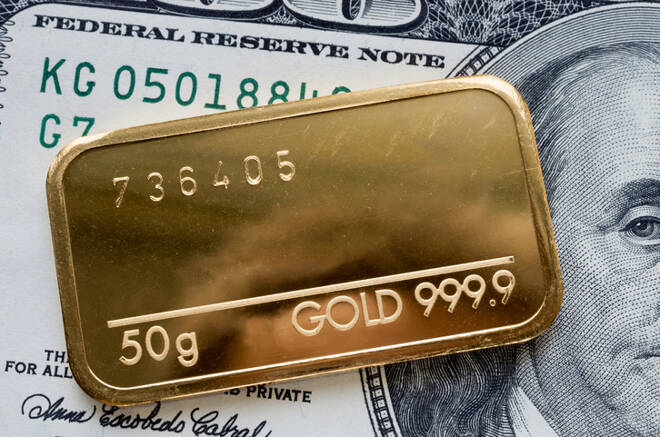Advertisement
Advertisement
Price of Gold Fundamental Weekly Forecast – Could Spike Higher if China Retaliates Against New U.S. Tariffs
By:
Given China’s retaliatory tariffs on Trump’s August 1 tariffs and the gold market’s reaction, we have to expect China to hit the U.S. with a countermeasure that could send gold prices even higher.
After consolidating for two weeks on below average volume and volatility, gold futures finished higher last week and in a position to challenge a six-year high after U.S. Treasury yields plunged and equities plummeted on increased fears of a U.S. recession. To a lesser degree, Fed Chairman Jerome Powell fueled some of the rally with dovish comments, however, most traders will agree it was the action of President Trump that triggered the biggest reaction in the gold market.
Last week, December Comex gold futures settled at $1537.60, up $14.00 or +0.92%.
Powell Set Early Bullish Tone
Federal Reserve Chairman told global investors on Friday the Fed is prepared to act to sustain the more than ten year recovery. Powell said the Fed stands ready to do whatever it takes to support the record-long U.S. economic expansion, while stating that international developments are weighing most heavily on the Fed’s decisions.
“Based on our assessment of the implications of these developments, we will act as appropriate to sustain the expansion,” Powell said at the central bankers’ symposium in Jackson Hole, Wyoming.
Powell also acknowledged Fed policymakers have a limited toolbox in how it can respond to an ongoing trade war with China, noting that monetary policy is a “powerful” but not universal tool.
Nonetheless, the Fed chief provided no clear indication of whether the Fed plans to meet the market’s demand for a 25-basis point rate cut in September and as many as four more over the next 12 months in an effort to continue the expansion and defend the U.S. against a recession.
Powell also said uncertainty caused by Trump’s tariffs on China and other trading partners is the major risks the Fed is monitoring. He also acknowledged that since the Fed’s first rate cut in ten years on July 31, market conditions “have been eventful, beginning with the announcement of new tariffs on imports from China,” he said.
Trump’s Comments Spike Prices Higher
After China retaliated with fresh tariffs and Fed Chairman Jerome Powell calmed the markets by seemingly opening the door to further rate cuts by saying the central bank stands ready to do what is necessary to support the record-long U.S. expansion on Friday, President Trump lit up the Twitterverse with a series of scathing tweets criticizing the Fed, Jerome Powell and China. But this time, he didn’t stop there, he took action that triggered a steep break in the stock market, while spiking demand for safe-haven assets.
Trump’s series of tweets damaged investor confidence in the economy, driving the major indexes sharply lower, with their fourth consecutive weekly loss. The blue chip Dow dropped about 1% this week while the benchmark S&P 500 pulled back 1.4%. The tech-based NASDAQ Composite Index lost 1.8%.
The plunge in the stock market set off a flurry of activity in the safe-haven markets. U.S. Treasury yields fell. Also, the yield curve inverted briefly again on Friday, but was mostly flat throughout the day. Gold surged 2% with some of the gains attributed to Powell’s dovish remarks. The Japanese Yen rose to a one-week high.
Weaker Dollar Drives Up Demand for Dollar-Denominated Gold
The U.S. Dollar plunged against a basket of currencies last week, falling from a three-week high, after President Donald Trump ordered U.S. companies to start looking for an alternative to China. The move took place in response to Beijing imposing more tariffs on American goods, further escalating tensions between the two economic powerhouses in a prolonged trade dispute.
A weaker dollar drives up demand for dollar-denominated assets like gold.
Weekly Forecast
The week’s important U.S. economic reports are Durable Goods, Conference Board Consumer Confidence, Preliminary GDP and Personal Spending.
Preliminary GDP is expected to come in at 2.0%, down from the first estimate of 2.1%. This is the major report in my opinion because this will let investors know how much closer the economy has moved toward a recession. Remember, the classic definition of a recession calls for 2 consecutive quarters of negative economic activity.
On Friday, after Trump’s initial Twitterstorms, the President announced that Washington will impose an additional 5% duty on Chinese goods. Trump said the United States would raise its existing tariffs on $250 billion worth of Chinese imports to 30% from the current 25% beginning on October 1, the 70th anniversary of the founding of the communist People’s Republic of China.
At the same time, Trump announced an increase in planned tariffs on the remaining $300 billion worth of Chinese goods to 15% from 10%. The United States will begin imposing those tariffs on some products starting September 1, but tariffs on about half of those goods have been delayed until December 15.
Given China’s retaliatory tariffs on Trump’s August 1 tariffs and the gold market’s reaction, we have to expect China to hit the U.S. with a countermeasure that could send gold prices even higher.
About the Author
James Hyerczykauthor
James Hyerczyk is a U.S. based seasoned technical analyst and educator with over 40 years of experience in market analysis and trading, specializing in chart patterns and price movement. He is the author of two books on technical analysis and has a background in both futures and stock markets.
Advertisement
